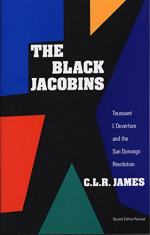|
This section contains 398 words (approx. 1 page at 400 words per page) |

|
The Black Jacobins Summary & Study Guide Description
The Black Jacobins Summary & Study Guide includes comprehensive information and analysis to help you understand the book. This study guide contains the following sections:
This detailed literature summary also contains Topics for Discussion on The Black Jacobins by James, C.L.R..
The following version of the book was used to create this study guide: James, C.L.R. The Black Jacobins. Vintage Books, 1989.
In The Black Jacobins, author C.L.R. James provides an historical account of the Haitian Revolution, which unfolded in the French-controlled West Indies colony of San Domingo in the wake of the French Revolution. In the first chapter, James focuses on the slave population in the island, which were owned as property by the focus of the second chapter: the white slave-owning classes. He specifically mentions a number of slave rebellions as evidence that the slaves were not the docile, happy folk that many slavery apologists made them out to be.
In the third chapter, “Parliament and Property,” James describes the debate that raged in French assembly houses over whether the colonialists or Mulattoes should be accepted as citizens in the republic. In the fourth chapter, “And the Paris Masses Complete,” James describes continued, strained relations between the Parisian metropolis and the colony, as well as the newfound threat of the British.
In the fifth chapter, “The Rise of Toussaint,” James describes Toussaint’s physical features, his relationship with the French general Laveaux, and his early efforts to consolidate his power on the island. The sixth chapter, “The Mulattoes Try and Fail,” details the efforts of the Mulatto class on the island to derail Toussaint’s power. The seventh chapter, “The White Slave-Owners Again,” chronicles French administrator Sonthonax’s departure from the island. In Chapter IX, “The Expulsion of the British,” Toussaint reluctantly agrees to aid the French in curbing the British assault on their territory.
Chapter X, “Toussaint Seizes Power,” foreshadows Toussaint’s tragic flaw (his inability to connect with the masses) as well as his final, complete domination of the island by driving his competitors out. Chapter XI, “The Black Consul,” describes Toussaint’s administrative decisions as well as the Constitution declaring the island’s relative independence from France.
In Chapter XII, “The Bourgeoisie Prepares to Restore Slavery,” describes a number of threats to Toussaint’s power. The final, long chapter, “The War of Independence” describes Napoleon Bonaparte’s plan to regain control of the island, Toussaint’s arrest by the French army official Leclerc, and Haiti’s Declaration of Independence, which was proclaimed in 1804. Finally, James concludes with the prediction that Africa will be the next to revolt against imperialism.
Read more from the Study Guide
|
This section contains 398 words (approx. 1 page at 400 words per page) |

|



